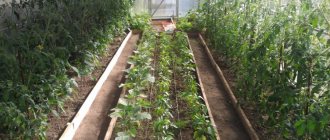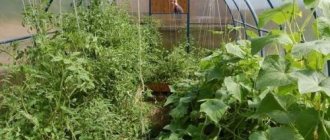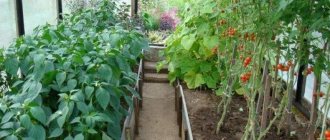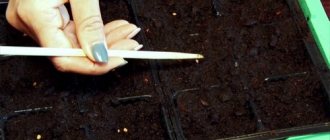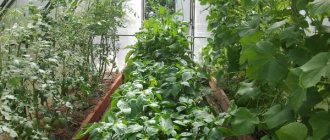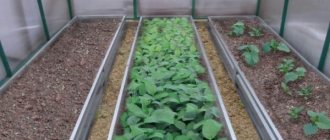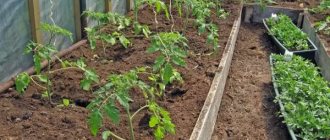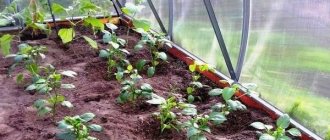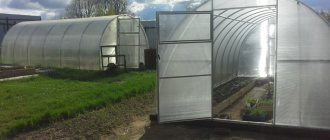Let's figure out how to properly use all the soil in the greenhouse. In order to get a significant harvest that will be ready for harvest earlier or will have time to ripen (applies to the northern regions), we plant vegetable crops in closed ground. Building a greenhouse takes a lot of effort, time and money, so I want to plant it as much as possible, and we often plant different crops close to each other. Incorrectly selected vegetables for joint growth can cause large losses in yield, so you need to know what you can plant with what in the greenhouse. Mostly heat-loving vegetables such as peppers, tomatoes, and cucumbers are grown in protected soil. If there is room left, I want to add something else. Many cultures are able to coexist peacefully, but there are also representatives whose presence will inhibit the growth and development of the main “settlers”. We suggest considering which joint plantings of vegetables in a greenhouse are acceptable and which are not.
Why is planting in protected soil necessary?
Today, not a single summer cottage is complete without a greenhouse or hothouse. Experienced gardeners claim that the harvest obtained from a greenhouse cannot be compared with that obtained from crops planted in open ground.
Many people grow not only tomatoes and cucumbers in greenhouses, but also root vegetables, herbs, and ornamental flowering plants. Such plantings allow you to monitor soil moisture and regulate temperature for better crop growth. Many novice gardeners do not know that they can plant together in a greenhouse, and it happens that their harvest turns out to be much poorer than that of a neighbor behind the fence who grows vegetables in ordinary beds. What's the matter? You just need to use the closed ground space wisely and not cram everything that comes to hand into one area. We suggest you figure out which vegetables can be planted in one greenhouse and which are not recommended.
Mixed planting of vegetables: in the garden, in the greenhouse, diagrams, video. Compatibility of vegetable crops.
Do you want to grow an unprecedented harvest on your garden plot? Try combining different types of vegetables and aromatic herbs in the garden. Mixed plantings of vegetable crops are gaining more and more popularity and will give results that will surprise you!
Mixed plantings increase yields and eliminate the use of chemicals
All gardeners are trying to get as much harvest as possible from their plot of land. Planting only one vegetable crop on it will not achieve a good result. Therefore, they try to plant the prepared land with different types of vegetables or berries. Mixed plantings help increase yields and eliminate the use of chemicals.
Preparing the greenhouse
Everything will grow ideally in closed ground. In the spring, when there is still snow in places, the greenhouse is already quite warm and nice, why would it just sit idle if you can get the first harvest of greens in it? Moreover, many crops are ideal predecessors for planting cucumbers and tomatoes. If you have plans to plant these particular vegetables, we suggest preparing the land, and at the same time enjoying the very first vitamins of green crops from your own garden bed before anyone else!
So, before planting the main crops in the greenhouse, germinate lettuce, watercress, parsley, onions (onion), dill, Chinese cabbage, and mustard in its soil. After harvesting, dig up the soil again, remove the remains of the grown plants and you can begin the main planting. The question of what can be planted together in a greenhouse is of interest to everyone, so it is worth thinking carefully before choosing vegetables.
For example, cucumbers and tomatoes will not grow very well together, since the crops require different temperature conditions. Eggplants generally do not like crowding and the proximity of other crops. But it is still possible to grow all these vegetables together, you just have to choose the right varieties and take action. By following our recommendations, you can achieve a high yield, even if your greenhouse is planted with different vegetables. What crops can be planted together? We suggest you start choosing neighbors for your tomatoes.
What kind of greenhouses are needed?
In the summer, lightweight film greenhouses would be an ideal option. A more solid option is unheated greenhouses covered with glass or polycarbonate. For year-round cultivation, permanent greenhouses with a heating system are suitable. Joint planting of vegetables in a polycarbonate greenhouse is considered the most practical today.
When planting plants, you need to keep in mind that requirements for humidity levels and temperatures may vary .
For optimal soil moisture, drip irrigation is recommended. Most crops prefer warm water , so you cannot connect directly to the water supply; you need a storage tank in which the moisture will be warmed.
In a year-round greenhouse, lighting is required. Vegetables that need bright light will require additional fluorescent bulbs. It is very convenient if the structure has two input blocks at opposite ends of the structure. This layout will help place crops with different requirements for temperature and air humidity and make it easier to care for plants.
What can you use to plant tomatoes in a greenhouse?
These vegetables like to grow in light, fertile soils rich in calcium. To increase productivity, it is necessary to produce stable fertilizing with calcium nitrate. If the soil in the greenhouse is fertilized with organic matter, then additional fertilizing will not be useful; on the contrary, it can be detrimental to the crop. “Overfed” tomatoes will gain green mass, but will produce few fruits, and they will be small. Tomatoes need ventilation, moderate air temperature, and abundant watering, which is done directly under the root. What can you use to plant tomatoes in a greenhouse? What crops will they adapt to?
You can plant early variety white cabbage nearby. Express, Ultra Early Miracle, Nakhodka will do. “At the feet” of the ridge, head and leaf lettuces will grow well. Also good neighbors would be Sugar Giant radishes, parsley and onions. Unfortunately, tomatoes will not be able to create a good union with fennel and dill, so avoid this combination.
Many gardeners make the grave mistake of planting cucumbers and tomatoes together in a greenhouse. If you do not have a separate space for cucumbers, then do not plant the crops in one bed, plant them in different ones and, which will be ideal, separate the plantings from each other with a bed of peppers. Planting tomatoes and hot peppers in the same greenhouse is unacceptable unless you are a gourmet and you are not bothered by the bitter-spicy taste of tomatoes, the bush of which can cross-pollinate with its hot neighbor.
Before looking for neighbors for cucumbers, we suggest finding out when you can plant cucumbers in a greenhouse with seeds.
Compatibility of vegetable crops in the garden
For each main vegetable crop, you can select a companion plant, interaction with which will stimulate growth, improve taste, providing both a biochemical and physical effect. Let's figure out how to choose the right companion plant and what combinations of vegetable crops attract beneficial insects.
What plants attract beneficial insects
Your garden plot must have conditions that attract beneficial insects. These include pollinating insects and insect predators. The latter fight pests, protecting vegetable crops from damage by them. Mixing the smells of different types of vegetables and plants creates a favorable environment for their habitat.
Especially beneficial insects are attracted to spicy herbs. Predatory flies and wasps are attracted by the smell of various varieties of mint - catnip, peppermint. Hoverflies, which destroy aphids and soft-bodied insects, prefer flat, open flowers of vegetable crops and plants.
Marjoram, lemon balm, thyme, chamomile attract insects that pollinate their inflorescences and other flowering ovaries. Earthworms will be attracted to your beds by onion feathers, valerian and chicory roots.
Overseeding white clover under cabbage attracts predatory insects and spiders that eat caterpillars. In addition, it reduces the number of cabbage aphids and root flies. By planting cabbage next to celery, you can ensure the destruction of flea beetles, and proximity to aromatic herbs will scare away egg-laying cabbage butterflies.
A radish in the same bed with cucumbers will protect against spider mites and leaf beetles. Not only useful plants attract pollinators to the garden. Don’t rush to fight dandelions in your garden beds – thanks to their strong root system, they extract calcium from the depths of the earth, and their bright flowers attract bees and other beneficial insects. The ethylene gas they produce promotes the rapid ripening of fruits and berries.
Good neighbors - vegetables in the garden
Legumes release nitrogen into the soil, which stimulates the growth of potatoes, radishes, and corn planted next to them.
Cucumbers and spinach are good neighbors for onions, thanks to them they grow well. Alternating rows of carrots and onions is a classic combination; they repel pests from each other and grow without overwhelming their neighbors.
Garlic and onions among strawberry tubers, although they will not affect the yield of the berries, will allow rational use of the area.
Parsley is the most common vegetable companion. They plant it on the sides of the bed next to tomatoes, strawberries, radishes, and lettuce.
Eggplants are famous for their compatibility with beans, peas, and basil. Zucchini accelerates its growth in the vicinity of mint, radishes and legumes.
Beets will give a good harvest if grown in the same bed with tomato seedlings and green salad.
grassia.ru
Rules for planting cucumbers
When to plant seeds depends on the region where the crop is grown and the greenhouse. If there is no artificial lighting and heating, then residents of the central and northern parts of Russia can begin planting in the middle and end of May, when the outside air temperature reaches +15 degrees. If you live in the southern part, then you can plant cucumber seeds in a greenhouse in April. The same period is relevant for greenhouses with heating and lighting.
Two days before planting, the seeds must be prepared. To do this, place them in the refrigerator or any other cool place for 24 hours. After the time has passed, prepare gauze bags, place a seed in each, and place in water for 12 hours. After this, take it out and leave the bags of seeds at room temperature; by the next day small sprouts will appear. If some seeds do not hatch, this will mean that they are empty and can be thrown away.
Types of beds for a greenhouse
Greenhouse beds are divided into ground, raised, in the form of separate boxes, and tabletop. All types of beds, except tabletop ones, can be insulated.
Above ground beds are the easiest to maintain. They are usually set up in small greenhouses for growing seedlings, forcing greens or several bushes of tomatoes and cucumbers. In such beds, the soil conditions do not provide for the normal development of vegetable and other crops and they are not used in large closed structures.
Table beds are laid on specially prepared racks. They are most convenient for growing seedlings, radishes, forcing herbs, and indoor flowers in pots.
The most common and convenient for caring for plants in large greenhouses are raised beds. They can be 20-30-50 cm high. In such beds it is easier to carry out excavation work (change and disinfect the soil) and care for plants. They warm up quickly. In cold regions, a layer of earth will create an additional thermal cushion, isolating it from the cold natural soil layer. With isolated beds it is easier to maintain paths. The ridges can be made in the form of separate boxes with bulk soil of the required height.
Sometimes in large greenhouses they install removable racks on which you can grow seedlings at the same time as forcing green plants in the beds. After selecting the seedlings, the racks are removed and base crops (cucumbers, tomatoes, etc.) are planted in the garden bed.
Zoning in a greenhouse. © misahay
What can you use to plant cucumbers in a greenhouse?
Planting seeds should be done using a single-line or two-line method. At the same time, there should be trellises in the garden bed, to which the plants must be tied for good fruiting. Cucumbers need abundant watering; if the crop lacks moisture, the fruits may have a bitter taste. In addition, it is necessary to consistently produce organic and mineral fertilizers. Cucumbers respond well to solutions of potassium sulfate, bird droppings and superphosphate. What can you use to plant cucumbers in a greenhouse?
If the cucumbers grow not just tied up, but there is a trellis, then they will not damage nearby crops with their tendrils, which they can get caught on. If there is enough space between the bushes, then you can plant white cabbage. Also excellent neighbors will be dill, parsley, fennel, basil, head and leaf lettuces, Siberian early ripening eggplant and Mushroom Picker's Dream, radish. Peppers and cucumbers can be planted together in a greenhouse, but the proximity of tomatoes is undesirable and is possible only if the ridge with them is fenced with another crop. Corn grows well next to cucumbers; they can coexist either in different or in the same bed. The only thing is that additional processing of plants may be necessary for fruit set.
The right combinations of crops: what to plant and with what in one greenhouse to get a lot of harvest
Reading time: 7 minutes Greenhouses have become an integral part of the life of summer residents. They help grow heat-loving crops in the middle and northern regions.
Modern industry offers its consumers structures made from a wide variety of materials - from wood to metal supports. But few people know how to effectively use a greenhouse on their site.
Advantages of growing plants in protected soil
Gardeners, when installing a greenhouse on their site, try to make maximum use of this space to plant a variety of crops in the neighborhood.
As a result, yields in protected soil are very different from those grown in open soil.
You can control the temperature and humidity inside. But even with these benefits, there are some rules.
Rules and principles of joint cultivation
Any planting is done the same way for all joint seedlings. First, the main crop is planted, then other plants are planted to it.
In this case, the most common vegetables are cucumbers and tomatoes. But they don't like close proximity. Then other vegetable crops are planted with them.
Proper placement of seedlings allows you to harvest more crops (see table of compatibility of greenhouse crops).
Crop rotation and seasonal planting: what to plant in spring, summer, autumn, year-round gardening
In order for the seedlings to produce a good harvest, low-growing plants should be planted after the main planting crop. For example, grow radishes (several types) in early April, then plant tomatoes or cucumbers after harvesting.
Early crops are planted first, then early ripening ones. And at the end of August they reach cold-resistant vegetation.
Compatibility table for greenhouse crops:
What can you use to grow tomatoes?
Tomato seedlings prefer light soil with a high calcium content. When using organic fertilizers, fertilizing is not necessary.
If tomatoes are “overfed,” instead of a good harvest, the number of green leaves will increase and the fruits will be small.
They require periodic ventilation. The culture cannot be overcooled or the temperature raised as for watermelons or melons. Water generously, but only to the very roots.
According to all these requirements, tomatoes will be good neighbors for early ripening white cabbage. At the end of the greenhouse, various lettuces (headed or leafy) can grow. Radishes, green onions and parsley take root well.
Experienced gardeners do not recommend planting fennel or dill together with any varieties of tomatoes.
What crops do cucumbers go with?
Cucumbers have their own peculiarity. Planting is carried out for each region at different times.
The culture loves light and warmth, so if there is no artificial lighting in the greenhouse, this should be done in mid (late) May for the northern and central regions.
In this case, the maximum temperature outside should be +15°C.
For southern regions, or greenhouses with lighting and heating, planting can begin in April.
In order to plant cucumber seedlings, use a one-line or two-line method.
Cucumbers are tied to trellises so that they bear fruit well.
They require abundant watering, otherwise the lack of moisture will affect their taste (they will become bitter).
If there is enough space around the seedlings, it is recommended to plant white cabbage. The following crops are considered good neighbors:
- dill;
- salads;
- Siberian early ripening eggplant;
- parsley;
- basil;
- eggplant Mushroom Picker's Dream;
- radish;
- bell pepper;
- fennel.
Peppers, eggplants, salad: successful combinations and the right proximity
Pepper
Peppers and eggplants are nightshades, so their proximity will not cause harm. But there is a rule according to which they should not be too close to each other.
Experienced farmers recommend digging beds as follows:
- eggplant;
- tomatoes;
- pepper.
You can plant basil and onions next to them.
Cucumbers are also considered good neighbors. This crop can be used to separate the tomato and tomato beds.
Eggplant
In order for eggplant seedlings to grow faster, they are grown in a greenhouse. The culture loves moisture, a lot of sunlight and good feeding.
ATTENTION! In order for the plant to develop, fertilizers should be alternated. The composition must contain a lot of calcium and potassium.
Seed spacing that is too short will reduce yield due to lack of sunlight. This is a very finicky plant.
It is very picky about its neighbors. Always keeps a good distance with crops such as tomatoes or eggplants.
It gets along with tomatoes only if the tomato variety is low-growing. But it goes well with onions and melon.
Salad
Prefers exclusively organic. It grows only in rows, between which there should be a distance of at least 20 cm.
With proper care, the crop can be harvested every two full weeks.
Pairs well with a variety of greens:
- basil;
- dill;
- parsley;
- other types of salads;
- bulb onions.
Cabbage: combination with zucchini
Cabbage is an ideal neighbor for almost all types of plants. It is a moisture-loving crop and unpretentious to grow. It goes well with any plant, including zucchini.
Therefore, many cultures coexist next to it. But white cabbage attracts many harmful insects with its smell. To get rid of cutworm larvae, farmers plant dill nearby.
Its specific smell will not only repel insects, but will also improve the quality of the vegetable.
To strengthen the immune system against diseases and harmful insects, the seeds are treated with potassium permanganate or a certain chemical. drug.
Tomato bushes cope with harmful insects no worse than dill.
It is advisable to completely fence the seedlings with bushes.
The exception is red cabbage, which is best planted separately.
Kohlrabi cabbage goes well with asparagus, peas, beans and garlic.
Watermelons and melons
Melon crops require special conditions. They came to us from southern countries. And only there there are ideal growing conditions for them.
Therefore, greenhouses for them are built high, and the ovaries are suspended almost from the ceiling, but so that the cold air does not freeze the fruits.
The structure must be sealed, without cracks or crevices. The culture must be completely isolated from fungal diseases. To do this, the frame and soil are sprayed with a special Bordeaux solution or a mixture of copper sulfate.
Typically, watermelons or melons are planted when the temperature inside the room reaches at least 25°C. They require a lot of light and little moisture. To prevent the greenhouse from standing idle, the entire soil is planted with early varieties of greens or radishes.
In conditions of low dampness and high temperature, eggplants and any varieties of tomatoes will be ideal neighbors. It is better not to plant cucumbers and bell peppers in such a microclimate.
ATTENTION! For seedlings of watermelons and melons in protected soil, it is recommended to choose varieties with medium-sized fruits. Medium or early maturing species are well suited.
Undesirable neighborhood
Tomatoes and cucumbers, as the main types of crops, can exist together only in a certain environment. But for other cultures these requirements are much more limited.
There is very limited space indoors and you have to choose what to plant first.
In this case, you should pay attention to “bad” neighbors who can spoil both the taste and fruitfulness of each other.
Hot peppers are bad neighbors for any crop. With their pungency, they will spoil the taste of any plant during pollination.
Therefore, they should be separated from other seedlings, or take risks if you like unusual tastes in vegetables.
Peas do not go well with tomatoes, and cucumbers do not go well with sage.
Tall crops that are planted after the base varieties cannot withstand competition and will “crush” other plants.
ATTENTION! Crops that are planted with the main varieties must be resistant to disease, pollinate well and be suitable for the environment.
Those who like drafts or water should not be planted with watermelons and melons.
Layout of a greenhouse with combined crops
All beds should be comfortable and as efficient as possible. Usually they are divided into 2 pieces. (70 - 80 cm wide), provided that the width of the greenhouse itself is 1.8 - 2 m.
The passage between them is 40 cm. It is covered with sand, crushed stone or tiles. This is done for convenience so that the farmer does not slip on the ground during watering or other work related to soil moisture.
On both sides, all ridges are fenced with boards, slate or other similar material so that the earth does not spill between the rows.
If the greenhouse is 3 to 3.5 m wide, the ground is divided into 3 strips with two paths. The side rows are placed along the long sides of the structure. The width is adjusted to the type of crops that will be grown on it.
ATTENTION! The side beds are made much narrower than the central row. This is due to the fact that they are processed only on one side, but the center can be served on both sides at once.
The central bed is usually double. It, depending on what grows on it, reaches up to 1.5 m.
Placement of seedlings, planted plants and growing crops
The most basic parameters when building a greenhouse are:
- lighting;
- air humidity control;
- soil moisture regulation;
- ventilation of the room;
- shade tolerance.
Given all these principles, it will be very difficult to accommodate diverse cultures. Especially if the area is small.
Light-loving crops are located on the south side. And plants that prefer drafts are near windows or vents.
In closed ground, all plants alternate along a decreasing trajectory.
Starting from the tops and ending with the roots (cabbage - cucumbers (tomatoes) - radishes (carrots, etc.)).
For large greenhouses, all plants are arranged according to the principle of growth. Those. tall crops are planted in the center, and then they begin (in descending order) to switch to medium-growing and low-growing varieties. So that no one blocks the lighting.
ATTENTION! With a lack of lighting, moisture and other conditions, the plant becomes vulnerable to diseases and harmful insects.
And the infected culture spreads its infection to healthy species.
Green manure plants: what are their benefits?
Green manures are plants that are grown for one purpose - to fertilize the soil. For greenhouses, this is an ideal option, given that the soil inside is in constant use.
Therefore, in order to restore their qualities, it is necessary either not to use the soil for 3-4 seasons, or to plant them with green manure. These include the following crops:
- oats;
- legumes;
- rye;
- beans;
- mustard.
Green manure is planted starting in spring according to the following scheme:
- Season 1. After gardeners have harvested cabbage, radishes, or parsley, the entire area is planted with clover or winter rapeseed.
- Season 2. The following year, the entire land is planted with any legume crops.
- Season 3. After harvesting the legumes, the soil is planted with buckwheat, sunflower, phacelia, and oats.
- Season 4. Potatoes and tomatoes.
- Season 5. Sweet clover and alfalfa.
- Season 6. Zucchini and cucumbers.
- Season 7. We heal the earth. Radish and mustard.
Useful tips from experienced summer residents
Experienced summer residents share their advice through online communities.
- To prevent the greenhouse from standing idle in early spring, it is recommended to sow it with greenery.
- April is ideal for planting early ripening beets. As soon as the seedlings have grown well, tomatoes can be planted between the rows.
- Melons and melons get along well with tomatoes. But they need to be seated on a separate row.
- To prevent the soil from becoming depleted, add the maximum amount of organic matter and minerals two weeks before planting.
- Disinfect the soil annually to protect crops from diseases and harmful insects.
A greenhouse is a special room where a microclimate is formed that can maintain ideal conditions for growing various plants.
Unlike open ground, inside you can control the temperature, humidity, and soil composition. But due to the limited area, crops have to be planted nearby. Not all of them get along with each other. Then we need to look for a compromise between plants in order to reap a good and tasty harvest.
Did this article help you? We would be grateful for your rating:
You have already voted
Planting pepper
Many gardeners grow sweet peppers. It is ideal for fresh consumption, has a pleasant taste and aroma, contains many vitamins, and perfectly complements a salad of fresh vegetables. Peppers are also used for preparations for the winter; there is nothing better than opening a fragrant jar of lecho on a frosty day, prepared from peppers grown on your own plot.
This crop can be planted in a checkerboard pattern; it is completely at ease with dense planting and shade, so feel free to plant seven plants per square meter. The denser the planting, the richer the harvest! Mineral and organic fertilizers, stable ventilation of the greenhouse, and good watering are needed. So, what can you use to plant peppers in a greenhouse?
Peppers go well with eggplants, since both crops are nightshades. But placing plants too close to each other can cause a decrease in the yield of both. We said that you can plant tomatoes and peppers in a greenhouse; they grow well nearby. If you want to place eggplants in the greenhouse, build the beds in this order: eggplants - tomatoes - peppers. Onions, lovage and basil will also not harm the peppers and will develop well themselves. Joint planting of cucumbers and peppers in a greenhouse can be done quite calmly; these crops are friendly.
Air temperature in the greenhouse
The air temperature in greenhouse structures may vary. As a rule, the air in the center is better heated than in the corners. Temperatures vary between day and night because the air outside the greenhouse is colder at night.
The temperature in the greenhouse can be adjusted using thermostats:
- Mechanical. The device allows you to adjust the temperature inside the greenhouse;
- Electronic. Such devices with precise settings allow you to set the temperature as accurately as possible;
- Sensory. The programmable device will monitor air and ground temperatures around the clock.
There are homemade thermostats. For example, a water one, consisting of several cans filled with water.
Eggplant
Many vegetable growers grow eggplants. The best option for planting a crop is in a greenhouse. In protected soil, the plant will develop faster, more ovaries will appear, and, accordingly, fruits. Growing in a greenhouse, eggplants will produce a larger harvest than when grown in open areas. The plant loves moisture, sun, and high-quality fertilizing. Fertilizers should be alternated. At the first stages of development, organic matter will be needed; at the stage of fruit ovary, mineral fertilizers, more calcium and potassium are needed. Do not plant the plants too densely; the yield will be significantly reduced due to lack of sun; eggplants do not like crowding.
What can you use to plant eggplants in a greenhouse if they are so capricious? Of course, co-growing is difficult, but it is still possible. We have already written that the culture gets along well with peppers and tomatoes. If the peppers should be located a little further away, fenced off by another ridge, then the tomatoes also need to be planted according to plan. First, there should be space between the eggplant and tomato beds to allow as much extra light as possible. Secondly, when planting tomatoes next to eggplants, choose a low-growing variety. If the tomatoes are tall, they will shade the eggplants, and they will grow small and the bushes will be weak.
Onions will grow well next to eggplants and will not harm their capricious neighbor. You can also plant a melon; it will also grow well in a greenhouse and will not shade the eggplants or interfere with their growth.
We propose to continue our review of what you can plant with in a greenhouse. Let's move on to the greens that people love to grow indoors. The thing is that in this way you can have fresh, young lettuce, dill, onions (feathers) on the table all season long, because with proper planting you can reap several harvests in a year.
Using a greenhouse to grow vegetable seedlings
Greenhouses with stationary heating are widely used in the north, in regions with short, cold summers. They are usually used year-round. In the southern, central black earth and other regions with a fairly long warm period, greenhouses are frozen out for the winter (the roof is opened) or allowed to rest and put into production in February for growing vegetable seedlings.
Depending on the region (see the article “Time for sowing vegetable crops for seedlings for different regions”) sowing for seedlings begins from the first days of February until April-May.
It is convenient to grow seedlings for a small greenhouse at home. To grow large quantities of seedlings of various vegetable crops, it is more practical to use one of the zones in the greenhouse. After selecting the seedlings, the vacated area is occupied by vegetable crops. You can use removable racks for seedlings.
Salad
This crop needs soil saturated with organic fertilizers. It is recommended to plant in rows, the distance between which will be on average twenty centimeters; this is necessary for the correct formation of the bushes. If you plant seeds every two weeks, the harvest will be stable and you will be able to have fresh salad greens until the end of the season. The culture loves good moisture, loose soil, and stable application of fertilizers. What can you plant in the same greenhouse with lettuce?
If you plan to have a greenhouse in which only greens will grow, you can plant dill, parsley, basil, onions and onions, head and leaf lettuces - all this is in perfect harmony with each other. The only thing is that you need to plant onions in a separate bed if you want to get onions, because a lot of space is needed to form the heads.
Cabbage, both leafy and cabbage, will grow well with salad. Lettuce can be planted between bushes of cucumbers, tomatoes and peppers. Eggplants will also sit comfortably next to salad. By planting these crops together, you will get rid of unnecessary hassle. That is, by fertilizing and watering tomatoes, cucumbers, peppers and eggplants, you will immediately carry out the necessary procedures for the salad. All these crops love moisture, loose soil, and fertilizing.
Growing tomatoes in a greenhouse
To grow tomato seedlings, you need to plant the seeds in containers. It is best to plant seeds in eraser containers using purchased soil, which can be very easily removed from the container and planted in the ground.
After the seedlings are planted in the ground, they should be watered generously and mulched with grass so that the soil retains moisture for as long as possible.
- Tomato seedlings should be watered regularly, but not overwatered, so that the root system does not begin to rot.
- Tomatoes need to be fertilized at least three times in one season.
- The first time is about a few weeks after the seedlings are planted in the ground.
- These plants especially need phosphorus. You can fertilize yourself by pouring a tablespoon of superphosphate into a bucket of water.
The mixture should be infused for 24 hours. Add bird droppings to the fertilizer. About a liter of fertilizer should be poured under each bush. Tomatoes are fed a second time after the second cluster blooms, and a third time after flowers appear on the third cluster.
Undesirable co-cultivation
We wrote that it is possible to combine tomatoes and cucumbers in the same greenhouse, but subject to certain rules. We have already covered what can be planted with in a greenhouse, and what crops cannot be combined, but what to do if you have closed soil worth its weight in gold, and you want to plant both cucumbers and tomatoes? Growing them together is not recommended, but you can still try. Use the following tips and you will not lose your harvest.
The first thing every vegetable grower should remember is that cucumbers, unlike tomatoes, do not like ventilation, they are too susceptible to infections, these delicate creatures love warmth, the absence of drafts, and if you do not follow the rules, there will be a lot of empty flowers, foliage will begin to turn yellow.
Cucumbers require greenhouse conditions for high-quality growth, a lot of water. And tomatoes can’t stand this. They need fresh air; too wet soil can cause rot in the roots and fungal diseases, which not only have a detrimental effect on the harvest, but can even destroy the plants. Of course, planting in separate beds is acceptable, but what to do with ventilation?
You can plant tomatoes closer to the exit, and place cucumbers in distant beds. If you plant them at the end, it will be possible to make a fence; for this you will need film. Attach it to the ceiling to form a curtain, take a wooden stick and attach it to the bottom of the film, wrapping it and securing it. Now you can lift this curtain to go to the cucumbers and carry out all the necessary procedures, and they will be fenced off from the tomatoes, and when ventilating a draft, the fence will not be lifted, since it is weighted with a stick. Cucumbers will grow quietly in their “greenhouse”, without interfering with the tomatoes, without sharing their heat and moisture with them, and you will use the entire space of the greenhouse, plant all the necessary crops, and the harvest will be high, since all conditions have been created for tomatoes and cucumbers good growth.
Hot peppers should never be planted in the same greenhouse with other crops. You can’t plant them together even with sweet peppers. During cross-pollination, which will definitely occur, the taste of tomatoes, cucumbers, and peppers will be spicy; there may even be a burning sensation characteristic of hot peppers. This way you will simply spoil the taste of the entire greenhouse harvest. For such a “hot” plant, create a small greenhouse in which it will be away from other crops.
It is worth remembering that planting green beans nearby will help increase the productivity of tomatoes, but peas are completely contraindicated for them. Cucumbers will not be able to live side by side with sage; it will inhibit the plant and cause low yields. Now we propose to move on to considering the question of what to do if you want to grow root crops or melons.
Criteria for selecting plants for compacted plantings
If you choose the wrong “neighbors” for a compacted bed, you may not see the harvest at all, because Some plants may stunt the development of others or attract their pests. Therefore, the main criterion when selecting crops for compact planting is their compatibility.
Taking into account the physical characteristics of plants, as well as their needs for nutrients, sunlight and watering, it is possible to determine how they will behave in joint plantings: will they help or, on the contrary, harm each other.
Almost all crops are negatively affected by proximity to fennel, ornamental beans and wormwood. Eggplants, for example, attract the Colorado potato beetle, while legumes repel it.
The proximity of garlic and onions with sage, legumes and cabbage, and tomatoes with turnips, potatoes, kohlrabi and peas is undesirable. Cabbage does not go well with parsley, carrots, tomatoes and beans. Potatoes with celery, pumpkin and cucumbers are also not the best neighbors.
The duration of the growing season of plants and their need for heat are important. It is better to plant crops with different ripening periods nearby. While the main plants are developing, additional ones have time to produce a harvest.
Therefore, often before planting seedlings of heat-loving crops such as tomatoes, eggplants or peppers, more cold-resistant ones are sown in the greenhouse: onions and garlic for feathers, lettuces, dill, Chinese cabbage, radishes, spinach and other early greens. By the time the main crops are planted, they are removed or left if the plants are compatible.
Plants should also be selected according to height. So, next to light-loving beets and peas, you can plant shade-tolerant onions, dill or lettuce. The main criterion for selecting cultures for their “neighborhood” is their compatibility.
Some plants can even improve the taste of others. Thus, basil and lettuce make tomatoes tastier, and dill makes cabbage tastier.
When selecting crops for compact planting, it is also necessary to determine the dominant, i.e. whose interests are a priority, and complementary plants. They are, as a rule, more compact, lower in height of the main crop, and their root system is less developed.
A little more about joint plantings
As mentioned earlier, so that the greenhouse does not stand idle in the spring, you can plant various greens in it, and after harvesting it, plant the main crops. We offer you another option. In April, you can plant early ripening beet varieties in the greenhouse. When the time comes to plant tomatoes, the root crops will already have grown well; calmly place the seedlings between them. Together, these crops will grow well and will not interfere with each other. When the tomato seedlings have grown to such an extent that they shade the beets, the root crops can be removed and they will be ready for harvesting. This way you can get early beets, and the greenhouse area will be used to the maximum. After harvesting the root crops, you can again “ennoble” the vacated areas by planting lettuce, dill and parsley, and you will again be a winner.
Watermelons and melons will grow well in a greenhouse together with tomatoes. Melons can be planted mixed with tomatoes, or in a separate bed. The second option is more acceptable, since melons and watermelons do not really like drafts, but they also do not need the greenhouse effect, like cucumbers. Simply plant the crop in a distant garden bed or along the walls of a greenhouse behind tomato bushes; watermelons and melons love a lot of sunlight. Planting melons for tomatoes is useful because their smell attracts more bees for pollination; insects, having flown in for the sweet aroma, will also take care of the tomatoes. Watermelons ripen no faster than many varieties of tomatoes; harvesting takes place on average ninety days after planting the seedlings. Thus, the greenhouse will be fully operational throughout the entire season.
We learned what can be planted with in a greenhouse, and what combinations should be avoided. But for the quality of the harvest, it is necessary to properly prepare the closed soil; it determines how well all the crops planted in the greenhouse will grow.
Placing a greenhouse on the site
In order for the greenhouse to have a lot of sunlight, it should be installed from north to south. So, the greenhouse will be illuminated all day: in the morning the sun will warm the beds that are planted on the eastern side, and in the afternoon - the beds on the western side.
- When installing a greenhouse, you need to take into account the slope of the site, prevailing winds and other nuances.
- If the greenhouse is located from the east to the west, then tall plants should be planted on the north side.
- In this case, low-growing plants are best placed along the southern wall.
Experts do not recommend placing cucumbers and tomatoes in one greenhouse; it is best to install several greenhouses on the site. This is due to the different growing conditions of plants: Tomato bushes like low humidity and good ventilation, while cucumbers like moist, stagnant air.
If it is not possible to install several greenhouses, then you can place cucumbers and nightshade representatives in one, following certain rules so that all plants are comfortable.
Preparing the greenhouse for the season
Vegetables planted in closed ground, unlike those grown in open ground, practically do not receive nutrients from the external environment, so it is worth taking care of the condition and maintenance of the soil in advance. In addition to regular fertilizing, cultivated plants need high-quality soil that will meet all the requirements - good breathability, absorbency, and light composition.
If the site is consistently used to install a greenhouse, then the soil is already quite depleted and cannot provide the plants with all the nutrients. The best option is to completely change the soil, removing the old one from the greenhouse and placing new one. If this is not possible, then enrichment measures can be carried out; to do this, add as much organic matter and mineral fertilizers as possible two weeks before planting.
In addition to fertilizers, the soil needs to be disinfected, because pathogenic bacteria and spores of fungal diseases could remain in it from last year’s crops.
If the greenhouse is being built on the site for the first time, it is worth correctly dividing the area into beds. Any length is possible, but the width should not be more than 90 centimeters. They can be located at a height (35-40 centimeters above the ground) or level with the ground. The soil must be mixed with peat, manure, and a complex of minerals.
By learning to properly use every centimeter of greenhouse soil, you will increase productivity and save land area.
Condensed plantings in the garden
Plantings can be compacted not only in the greenhouse, but also in the garden bed. By planting certain plants nearby, you can influence their productivity and taste, as well as protect them from diseases and pests. In addition, labor costs for caring for plantings are reduced.
Summer cabbage, for example, is best planted next to celery, which protects it from the main pest - cabbage whites. The “neighbor” is in no hurry to grow while the cabbage heads are forming, because... it has a later period of maturation. After harvesting it, the celery will still have enough time to ripen.
But it’s a good idea to “dilute” beds with strawberries with garlic and parsley, which not only do not interfere with their development, but also save them from snails, slugs and other pests. Garlic can be planted between the bushes of garden strawberries (as shown in the diagram), and parsley and other greens can be planted between the rows.
Everyone probably knows about the mutually beneficial relationship between carrots and onions. Planted nearby, these crops repel the most formidable pests. The onion fly does not like the smell of carrots, and the aroma of onions is disgusting to the carrot fly.
Many flower and spice crops also have the ability to repel insects and pests. These are marigolds, chrysanthemums, nasturtium, calendula, lavender, sage, rosemary, matthiola, coriander, etc. It is enough to plant them between the rows or around the beds, and natural protection for your plantings will be provided.
Some plants are not only able to scare away pests from the “neighbor”, but also feed it. This primarily applies to legumes, which saturate the soil with nitrogen. Potatoes will be especially welcome as such a companion. However, this neighborhood is mutually beneficial, because it protects the “neighbors” from their pests.
Beans and beans can be planted around the perimeter of potato rows, as shown in the diagram. It is better to plant beans at the ends of the “second bread” furrows so as not to damage them during hilling of the crop.
In the beds, the crops of beets, carrots and parsley can be compacted with radishes or lettuce, after harvesting which will free up enough space for the growth and development of the main crops. In addition, these “compactors” can serve as guides for the rows, so that when weeding you do not accidentally remove small root crops.
Growing vegetables in compacted plantings is not as difficult as it might seem at first glance. Here you need to monitor the timing of planting and harvesting crops, select them according to their compatibility and use protective equipment.
Such beds will also require a 1.5-fold increase in the amount of fertilizer per unit area so that all the plants have enough food for them.
Even in a small plot or in a small greenhouse, with the correct selection and placement of main and additional crops, using compaction planting, you can get good yields, of course, not forgetting the rules of crop rotation and plant care.
Source
What to plant next to peppers
All nightshades (peppers, tomatoes and eggplants) can live well together. But some very close plantings will not allow you to get a rich harvest. So, it is better to plant peppers away from eggplants. A successful solution to this problem is to organize the beds in the following sequence: pepper, tomato, eggplant.
You can also plant basil, lovage, cucumber, and onions next to the peppers. But fennel is not suitable for the role of a good neighbor.
Peppers grow well next to tomatoes and cucumbers and a little away from eggplants
Joint planting in a greenhouse, or What vegetables can be planted nearby
Adding an article to a new collection
Let’s figure out how to intelligently “populate” the entire soil in a greenhouse with vegetables, and at the same time increase productivity.
To get record harvests, residents of the northern regions have to grow heat-loving crops in protected soil. Since building a greenhouse takes a lot of time, effort and finances, we try to use the soil as economically as possible. Therefore, we plant vegetables close to each other.
The wrong choice of neighbors can lead to significant crop losses. To prevent this, you need to carefully consider the design of the beds.
In protected soil, gardeners most often grow tomatoes, cucumbers, peppers and eggplants. But I really want to plant at least a couple of other crops in the empty plots of land. Some plants coexist peacefully with each other, but particularly capricious “invaders” can slow down the development of the main vegetables growing in the greenhouse.
What to plant next to eggplants
These plants are quite finicky, so it is not recommended to plant anything next to them, so as not to shade or thicken the plantings. But if every centimeter in the greenhouse is worth its weight in gold, you can “settle” onions, melons and low-growing varieties of tomatoes next to the eggplants.
If eggplants do not develop well in your greenhouse, do not grow them next to other crops.
Use every centimeter of your greenhouse or greenhouse rationally. Grow greens there in early spring. And with the onset of warmth, having enjoyed plenty of vitamin crops, give this place to heat-loving tomatoes, cucumbers, peppers and eggplants.
Source
What are compacted or mixed plantings?
Condensed planting involves the joint placement of several different crops in a small area of the garden (greenhouse), which have a beneficial effect on each other without competing for vital resources. First of all, this saves land area, as well as your energy and time for processing the site. In addition, the fruiting period of plants will lengthen, and you will collect more crops from one bed.
Of course, with this type of farming it is necessary to take into account the needs of plants, as well as the characteristics of their cultivation and possible options for influencing each other, and only then form the right combinations. Plants should not interfere with each other, and ideally, protect them from pests and weather conditions, and even increase the yield of their neighbors.
